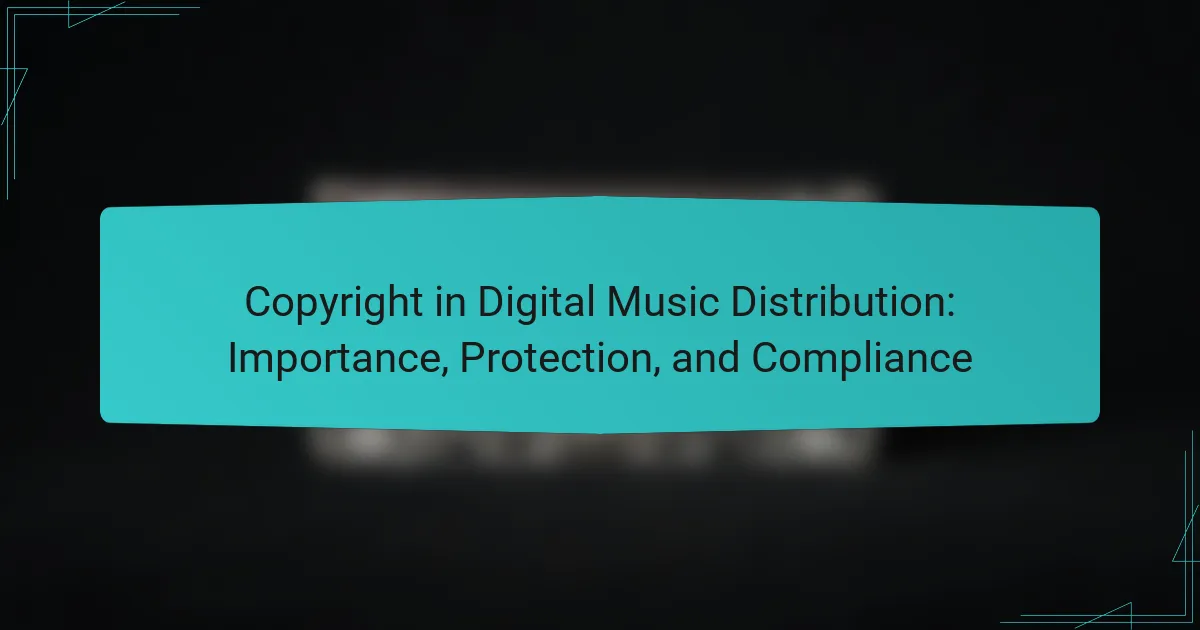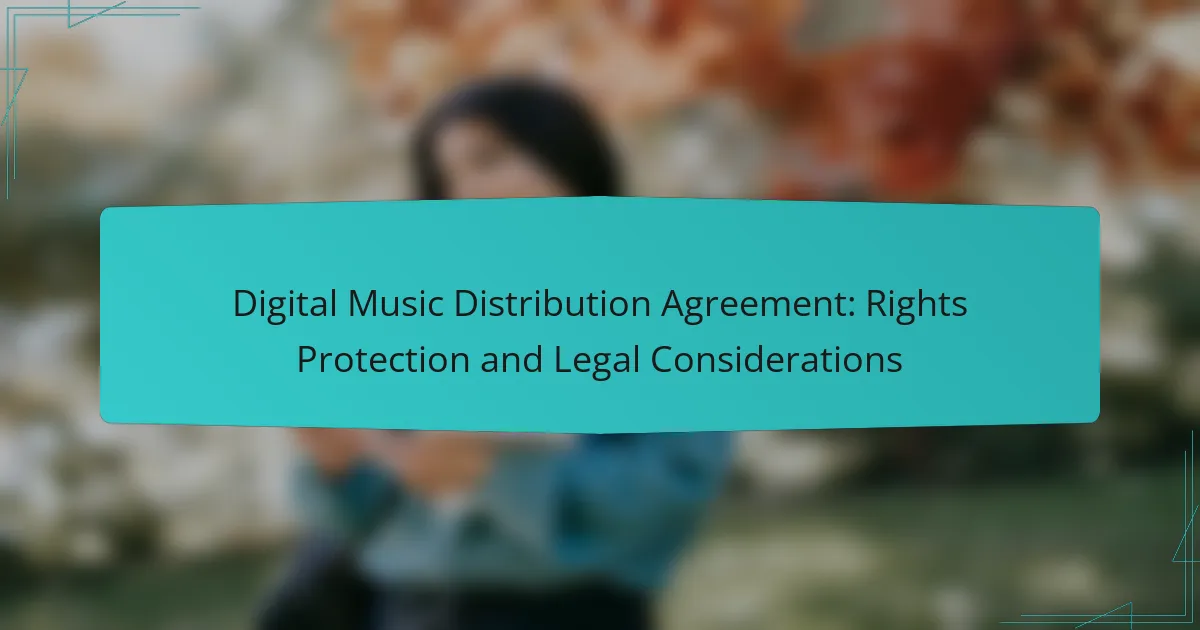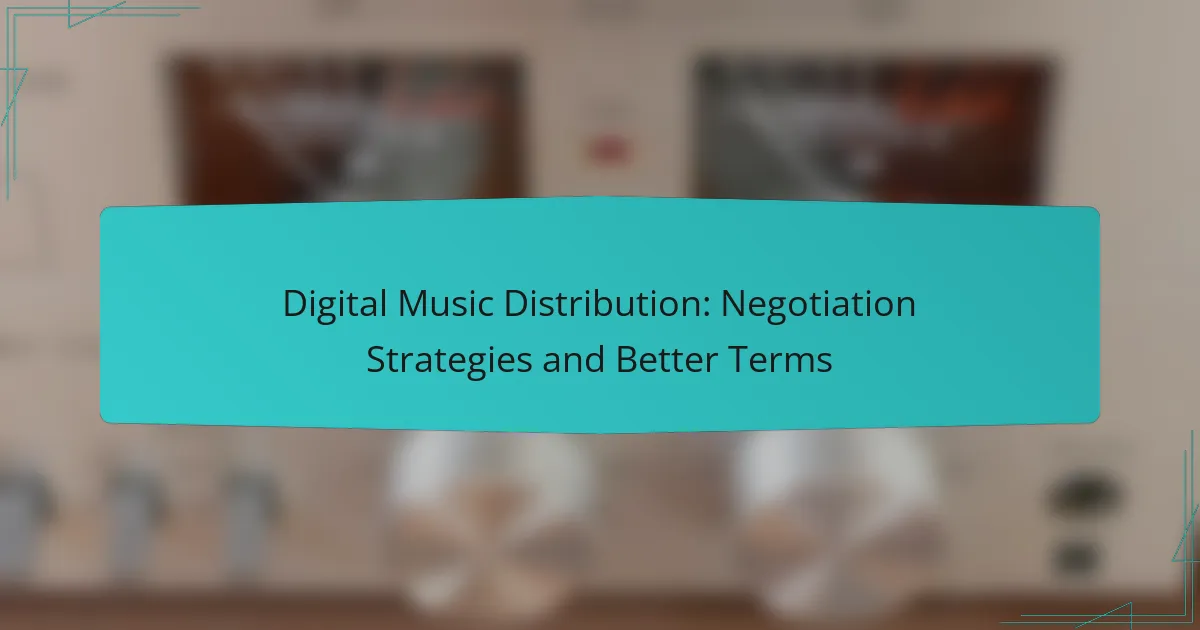Copyright plays a crucial role in digital music distribution by granting creators exclusive rights over their works, which helps prevent unauthorized use and ensures artists can earn revenue. Compliance with licensing requirements and accurate reporting is essential for music distributors to operate legally and fairly. By registering copyrights and using digital rights management tools, artists can protect their intellectual property and secure appropriate compensation for their creations.

How does copyright protect digital music distribution?
Copyright protects digital music distribution by granting exclusive rights to creators over their works, ensuring they control how their music is used and distributed. This legal framework helps prevent unauthorized use and allows artists to earn revenue from their creations.
Legal framework for copyright
The legal framework for copyright in digital music distribution is primarily governed by national laws and international treaties, such as the Berne Convention. These laws establish the duration of copyright protection, typically lasting the life of the creator plus several decades, depending on the jurisdiction.
In the United States, the Copyright Act of 1976 outlines the rights of creators and the process for registration. In the European Union, the Copyright Directive provides similar protections, emphasizing the importance of harmonizing copyright laws across member states.
Rights of music creators
Music creators hold several key rights under copyright law, including the right to reproduce, distribute, and publicly perform their works. These rights enable them to control how their music is shared and monetized, whether through streaming services, downloads, or physical sales.
Additionally, creators can license their music to others, allowing for various uses while retaining ownership. This licensing can be exclusive or non-exclusive, impacting how revenue is generated from their music.
Impact on distribution platforms
Distribution platforms must comply with copyright laws to avoid legal repercussions, which can include hefty fines or the removal of content. They often implement measures such as content identification systems to ensure that copyrighted material is not used without permission.
Platforms like Spotify and Apple Music typically negotiate licensing agreements with rights holders, ensuring that creators receive compensation for their work. This compliance not only protects the platform legally but also fosters trust with artists and consumers alike.
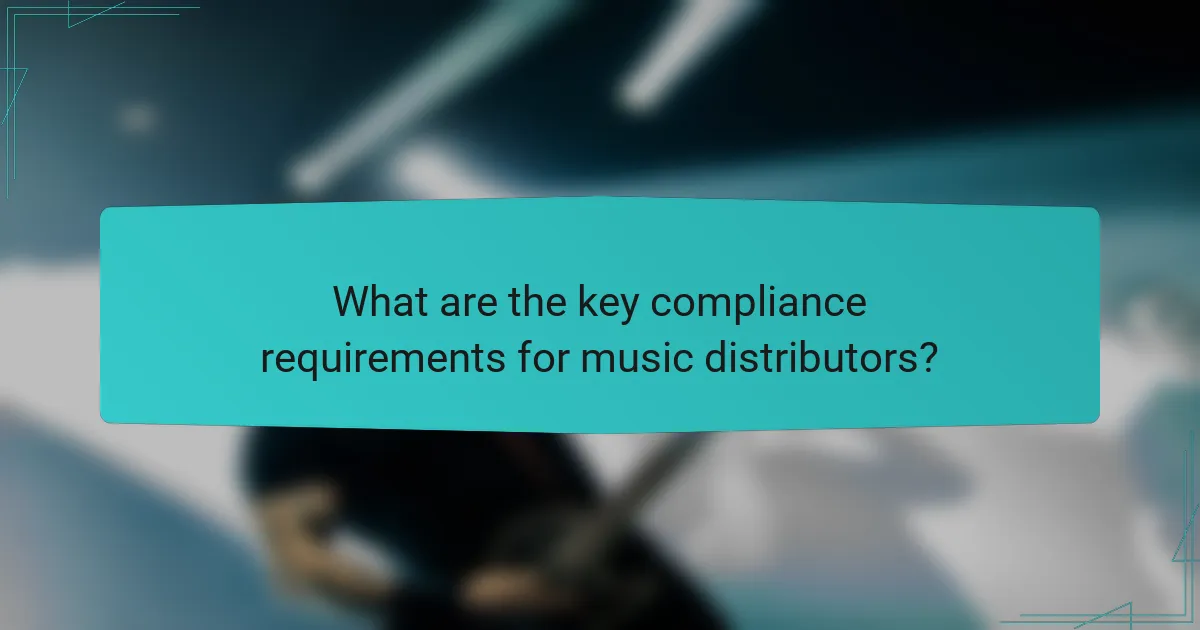
What are the key compliance requirements for music distributors?
Music distributors must adhere to several compliance requirements to operate legally and effectively. These include obtaining necessary licenses, accurately reporting music usage, and ensuring fair royalty distribution to rights holders.
Licensing obligations
Music distributors are required to secure various licenses to legally distribute music. This typically includes mechanical licenses for reproducing songs and synchronization licenses for pairing music with visual media. Distributors should ensure they are familiar with the specific licensing requirements in their operating regions, as these can vary significantly.
In the United States, for example, the Copyright Act mandates that distributors obtain licenses from rights organizations like the Harry Fox Agency or directly from copyright holders. Failure to secure these licenses can result in legal penalties and financial liabilities.
Reporting and royalty distribution
Accurate reporting of music usage is crucial for ensuring that royalties are distributed fairly among rights holders. Distributors must track and report data on how often songs are streamed or downloaded, often using digital tools and analytics platforms. This data is essential for calculating the royalties owed to artists, songwriters, and producers.
Royalty distribution practices can vary, but it is common for distributors to pay out royalties on a quarterly basis. They should maintain transparency in their reporting processes to build trust with artists and rights holders. Common pitfalls include underreporting usage or failing to provide timely payments, which can damage relationships and lead to disputes.
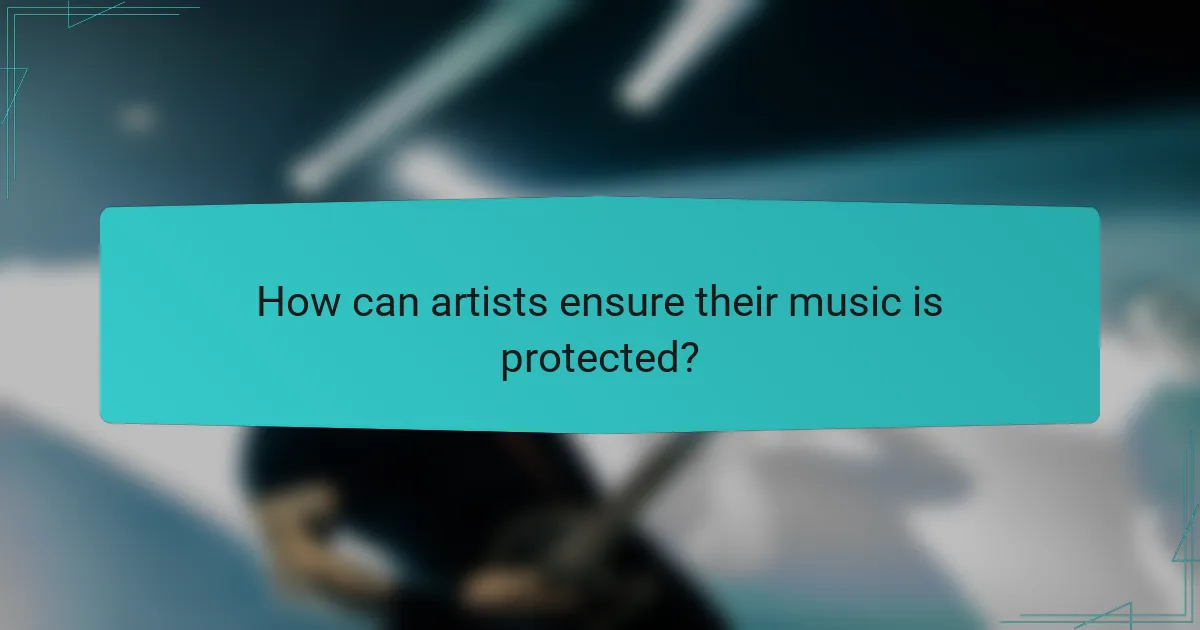
How can artists ensure their music is protected?
Artists can protect their music by registering copyrights and utilizing digital rights management tools. These steps help secure their intellectual property and ensure they receive appropriate compensation for their work.
Registering copyrights
Registering copyrights is a crucial step for artists to legally protect their music. In the United States, for example, registration with the U.S. Copyright Office provides legal advantages, including the ability to sue for damages in case of infringement. Artists should consider registering their works as soon as they are created to establish ownership.
The process typically involves filling out an application form, submitting a copy of the music, and paying a fee, which can range from around $35 to $85 depending on the type of registration. It’s advisable to keep records of all submissions and correspondence related to the registration.
Using digital rights management tools
Digital rights management (DRM) tools help artists control how their music is distributed and used online. These technologies can prevent unauthorized copying and sharing, ensuring that artists maintain their rights and receive fair compensation. Common DRM solutions include encryption and licensing systems that restrict access to the content.
When selecting DRM tools, artists should evaluate their effectiveness, ease of use, and compatibility with various platforms. It’s important to balance protection with user experience; overly restrictive measures may alienate potential listeners. Regularly reviewing and updating DRM strategies can help adapt to changing technology and market conditions.

What are the challenges in copyright enforcement?
Copyright enforcement in digital music distribution faces significant challenges due to the vastness of online platforms and the ease of content sharing. Infringement detection, legal disputes, and compliance with varying regulations complicate the protection of intellectual property rights.
Infringement detection
Detecting copyright infringement in digital music can be complex due to the sheer volume of content uploaded daily. Automated systems, such as Content ID on platforms like YouTube, help identify unauthorized use of copyrighted material, but they are not foolproof. Manual monitoring may still be necessary to catch instances that automated systems miss.
Rights holders should consider using a combination of automated tools and human oversight to effectively monitor their works. Regular audits of platforms where their music is distributed can help identify unauthorized use early, allowing for timely action.
Legal disputes and resolutions
Legal disputes over copyright infringement can be lengthy and costly, often involving negotiations, settlements, or litigation. Many disputes arise from unclear licensing agreements or misunderstandings about fair use, which can vary significantly by jurisdiction. In the U.S., for example, the fair use doctrine allows limited use of copyrighted material without permission under certain conditions.
To minimize legal risks, artists and distributors should ensure that all agreements are clear and comprehensive. Seeking legal advice when drafting contracts can help clarify rights and obligations, reducing the likelihood of disputes. Additionally, alternative dispute resolution methods, such as mediation, can provide quicker and less expensive solutions compared to traditional litigation.
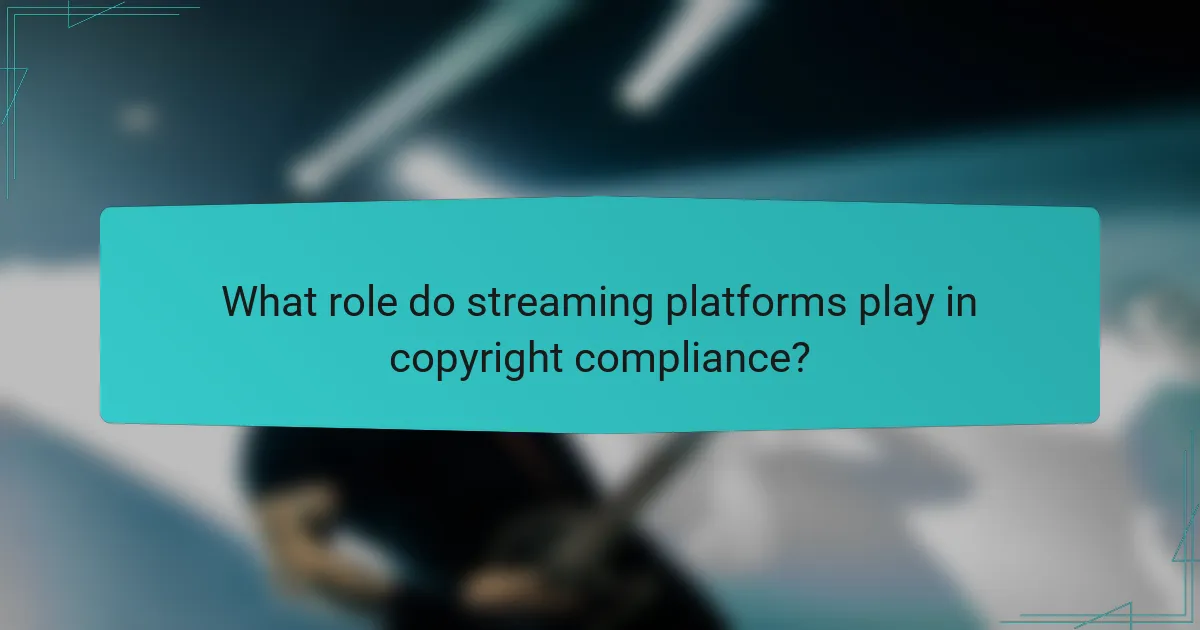
What role do streaming platforms play in copyright compliance?
Streaming platforms are crucial in ensuring copyright compliance by implementing systems that detect and manage copyrighted content. They facilitate the licensing process, enabling artists and rights holders to receive compensation for their work while providing users access to a vast library of music.
Content identification systems
Content identification systems are technologies used by streaming platforms to automatically detect copyrighted material. These systems analyze audio and video files to match them against a database of registered works, ensuring that any unauthorized use is flagged. For example, platforms like YouTube utilize Content ID, which scans uploads and monetizes or removes infringing content.
These systems can significantly reduce copyright infringement, but they are not foolproof. Occasionally, legitimate uses may be mistakenly flagged, leading to disputes. It’s essential for creators to understand how these systems work and to monitor their content regularly.
Partnerships with rights organizations
Streaming platforms often partner with rights organizations to streamline the licensing process and ensure compliance with copyright laws. These partnerships help platforms manage royalties and distribute payments to artists and rights holders efficiently. Organizations like ASCAP and BMI in the U.S. play a vital role in this ecosystem.
By collaborating with these organizations, streaming services can provide a transparent and fair compensation model for artists. However, rights holders should remain proactive in understanding their agreements and the distribution of royalties to avoid potential pitfalls in revenue collection.

How can independent artists navigate copyright issues?
Independent artists can effectively navigate copyright issues by understanding their rights and utilizing available resources. This includes leveraging digital distribution platforms and being aware of fair use policies to protect their work while maximizing exposure.
Utilizing platforms like TuneCore
Platforms like TuneCore provide independent artists with tools to distribute their music while ensuring copyright protection. By using such services, artists can retain ownership of their work and receive royalties from various streaming services.
When choosing a distribution platform, consider factors such as fees, payout structures, and the range of services offered. For example, TuneCore charges a flat fee for distribution, allowing artists to keep 100% of their earnings, which can be beneficial for those starting out.
Understanding fair use policies
Fair use policies allow for limited use of copyrighted material without permission, but they can be complex. Independent artists should familiarize themselves with the four factors that determine fair use: purpose, nature, amount, and effect on the market.
For example, using a short clip of a song for commentary or criticism may qualify as fair use, while using a substantial portion for commercial purposes likely will not. Artists should always consider seeking legal advice when in doubt to avoid potential infringement issues.
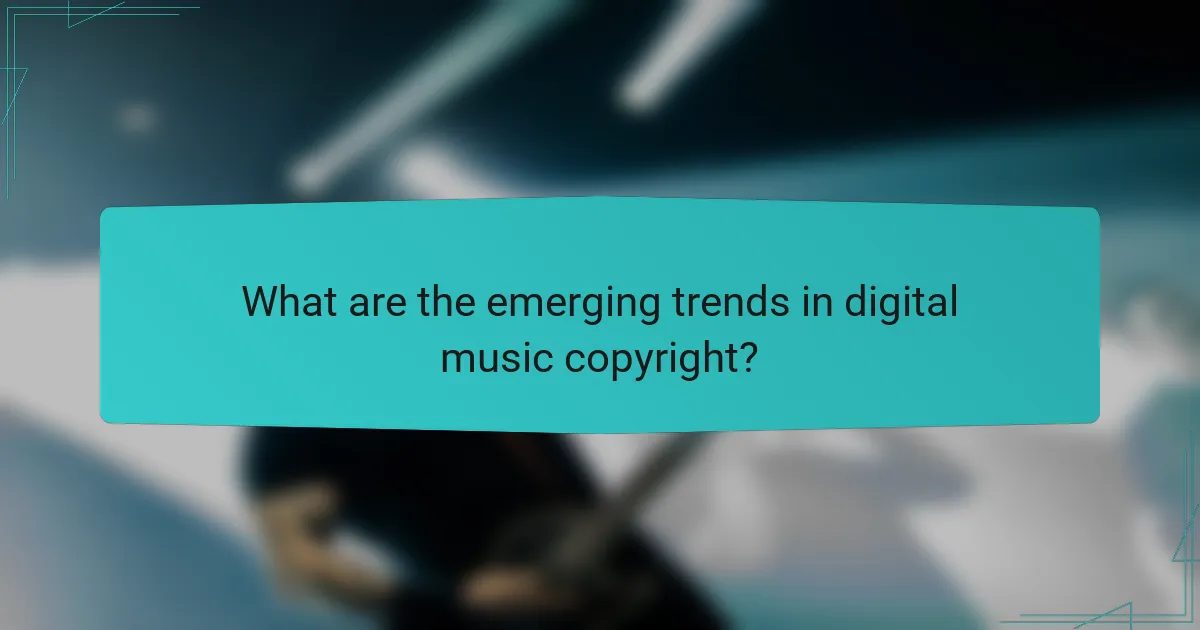
What are the emerging trends in digital music copyright?
Emerging trends in digital music copyright focus on innovative technologies like blockchain and artificial intelligence, which enhance copyright management and enforcement. These advancements aim to simplify the tracking of music usage and ensure that creators receive fair compensation for their work.
Blockchain for copyright management
Blockchain technology offers a decentralized and transparent method for managing music copyrights. By recording ownership and usage rights on a blockchain, artists can ensure their work is protected and easily traceable, reducing disputes over ownership.
For example, platforms utilizing blockchain can automatically distribute royalties based on smart contracts, ensuring that payments are made promptly and accurately. This method can significantly lower administrative costs and improve efficiency in royalty distribution.
AI in copyright enforcement
Artificial intelligence is increasingly used to monitor and enforce copyright in digital music. AI algorithms can analyze vast amounts of data to detect unauthorized use of music across various platforms, helping rights holders take swift action against infringements.
Additionally, AI tools can assist in identifying potential copyright violations by scanning user-generated content on social media and streaming services. This proactive approach allows artists and labels to protect their intellectual property more effectively, reducing the risk of revenue loss.
